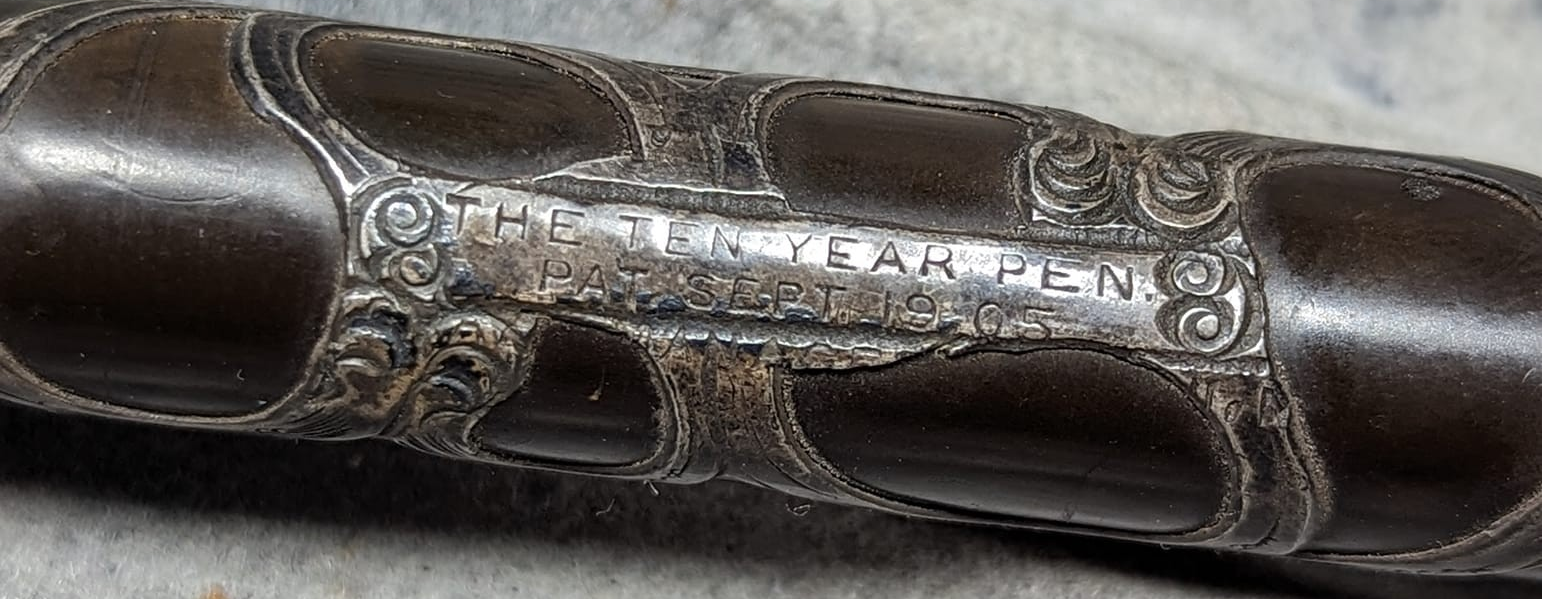 |
| The Congregationalist, 8 Sep 1906, p. 321 |
In was in the first decade of the 20th century that the self-filling fountain pen came into its own. Scores of ingenious filling mechanisms were patented, many even making it into production -- though often not for long. One design that proved lasting was the sleeve or thumb-filler, in which a manually-depressed pressure bar was by various means made either accessible for filling or safely concealed for use.
One of the earliest sleeve-filling fountain pens was the Ten Year Pen. In this variation the back half of the barrel was the sleeve, sliding over a metal sac housing with a cutout for access to the pressure bar. The first advertisements appear in the last quarter of 1906. Most ran in religious periodicals such as The Congregationalist and Christian World, The Christian Advocate and Journal, The Church School Adjuster, and the Baptist Standard, but ads also are found in publications such as The Mercantile Adjuster, The American Review of Reviews, and The Etude (for music teachers). In all these early ads the company is listed as The Ten Year Guarantee Pen Company of Ansonia, Connecticut. The earliest mention of the company I have found is in The Missionary Herald of July 1906, where it is listed as having given a donation of $15 in May of that year.
| Expositor and Current Anecdotes, Dec 1907, p. 146 |
From the end of 1907 there is no more mention of The Ten Year Guarantee Pen Company or Ansonia. The pen is henceforth styled "The Ten-Year Pen", and shown with a cap imprint identifying George B. Graff of Boston as "Manager" (F. M. Barton in the ad above was the publisher of the magazine, who in an arrangement common in that era was also a sales agent for the items advertised there).
 |
| The Ecclesiastical Review, vol. 39, 1908 |
The George B. Graff Company was an established Boston manufacturer of stationery supplies such as paper fasteners and clamps. Adding a fountain pen to their line would not have been such a stretch; the original Ten Year Guarantee Pens surely were made under contract -- the area of Connecticut comprising Ansonia and Seymour was home to Day Rubber and had been a center of contract manufacture of hard rubber pens and pen parts for decades -- so however the transfer was effected, it would not have involved the kind of capital required for actual factory ownership.
| Gregg Writer, Sep 1915, pp. vii |
Ten-Year Pens aren't often seen, even by those who have been hunting in the company's home territories for years. Most examples are plain black hard rubber, though gold filled bands were advertised as an option. Several overlay examples are known in both gold filled and silver, the filigree overlays undoubtedly sourced from Heath. The pen shown here belongs to Gabriel Galicia Goldsmith, who generously gave permission to use his photos for this post.
There has been some confusion about the parentage of the Ten-Year Pen. As long ago as the 1990s collector lore was associating the pen with William I. Ferris, unlikely as that would have been given Ferris's central position at Waterman. Whether such a connection was posited in print, I have not been able to determine (it is not mentioned in the big Fischler and Schneider volumes, nor in the Pen Fanciers' Magazine). How it came about is easy to see, though. The patent date that appears on the pens and in advertisements is September 19, 1905, which is the issue date of Ferris's first sleeve-filler patent, US799897. Yet if one examines that patent it is clearly not relevant: it is for a one-piece barrel with an aperture, covered by a rotating sleeve with a matching aperture -- a design never used for Waterman-branded pens, but produced as Remex and Aikin Lambert models. There were at least three other fountain pen patents issued on that same date, however, with Robert W. Gorham's patent US800129 clearly being the one referenced in the Ten-Year Pen imprint.










